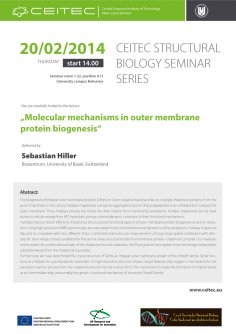Abstract:
The biogenesis of integral outer membrane proteins (Omps) in Gram-negative bacteria relies on multiple chaperone proteins. From the point of synthesis in the cytosol, holdase chaperones convey the aggregation-prone Omp polypeptides in an unfolded form towards the outer membrane. There, foldases process the Omps into their mature form. Importantly, periplasmic holdase chaperones do not have access to cellular energy from ATP hydrolysis, posing a thermodynamic constraint to their functional mechanisms.
I will describe our recent efforts to characterize structural and functional aspects of outer membrane protein biogenesis at atomic resolution. Using high-resolution NMR spectroscopy, we have determined conformations and dynamics of the periplasmic holdase chaperone Skp and its complexes with two different Omps. Combined intermolecular measurements of long-range spatial correlations with site-specific short-range contacts enabled the first atomic-level structural model of a membrane-protein–chaperone complex. Our measurements reveal the conformational state of the chaperone-bound substrates, the “fluid globule”, and explain how the energy-independent substrate release from the chaperone is possible.
Furthermore, we have determined the crystal structure of TamA, an integral outer membrane protein of the Omp85 family. TamA functions as a foldase for autotransporter substrates. Its high-resolution structure shows unique features that suggest a mechanism for the substrate insertion process from the chaperone-bound into the mature form. This mechanism includes the formation of a hybrid barrel as an intermediate step, presumably the generic functional mechanism of the entire Omp85 family.
Poster to download can be found HERE.









